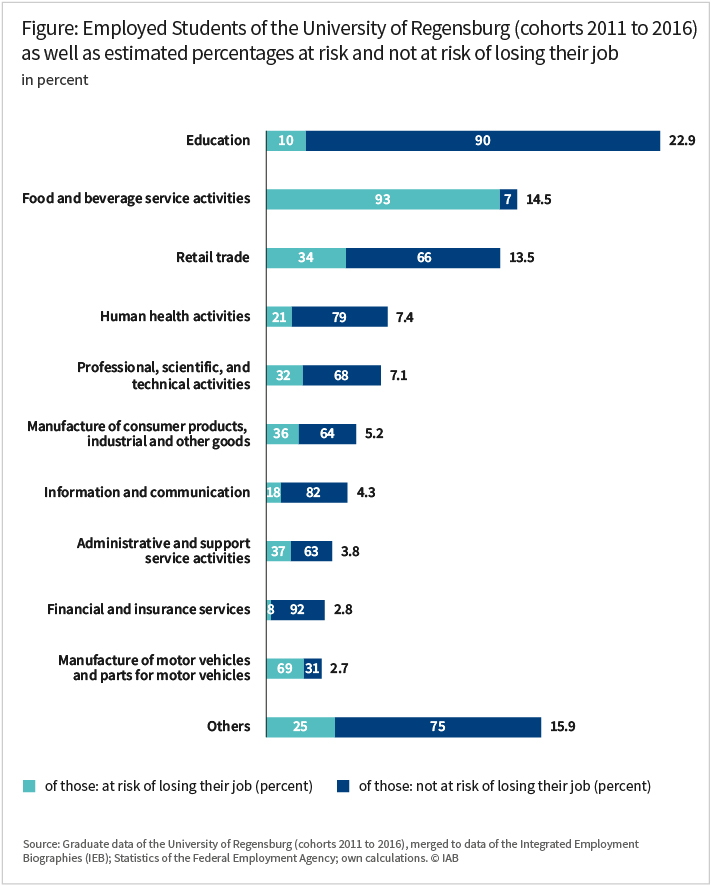20. November 2020 | Series "Covid-19 crisis: consequences for the labour market"
To work or not to work? A case study on the structure of student employment and its possible effects on students’ jobs during the Corona crisis
Bernhard Christoph , Nele Jugenheimer , Malte Sandner , Ipek Yükselen

The Covid-19 pandemic involves numerous burdens for the population. Among these, the effects of social distancing are particularly noticeable. In the case of students, social distancing measures might interfere with universities’ teaching activities, thereby making it more difficult for students to earn course credits in time. Ultimately, this might jeopardize students’ academic success.
In addition to this, students might get under financial pressure as economic activities shut down in sectors, which previously offered students good employment opportunities. This is even more true as students often work in marginal employment, where they are not eligible to social security benefits, such as the short-time work allowance. Therefore, losing one’s job can easily result in a considerable loss of income.
This problem has also attracted the attention of policy makers. The Federal Government, for example, has approved student loans and temporary aid of up to 500 euro for affected students. However, there is hardly any reliable data on job losses among students. The main reason for this is that students’ jobs are in most cases not covered by official statistics. The latter is largely due to the fact that social policy measures—which typically target employees that are subject to social security contributions—are not applicable to students working in marginal employment.
This report provides an overview of the structure of student employment, and estimates the extent to which students’ jobs have been cut or could be threatened in the current crisis—for example due to reduced economic activity of their employer or establishment closure. The data we use in this analysis link information on graduates from the University of Regensburg to register data from the Federal Employment Agency. Thus, these data allow us to analyse detailed study-related information on students in combination with information on employment and employers during their studies.
Income from employment accounts for slightly more than a quarter of students’ budget
Earnings from side jobs make up for a considerable part of students’ incomes. According to results of the most recent Social Survey (Sozialerhebung) of the German National Association for Student Affairs (Deutsches Studentenwerk) published in 2017 by Elke Middendorf and her team, 61 percent of students in Germany earn, on average, 385 euro from employment. However, in most cases, this is not the main source of students’ income.
Averaging over all students, income from employment accounts for 26 percent of the mean student budget of 917 euro. In contrast, financial support from parents is almost twice as high, amounting to 51 percent of the students’ budget. Moreover, a vast majority of students (86 percent) receive such financial support from their parents.
With 12 percent each, transfers under the Federal Training Assistance Act (BAföG) as well as other payments constitute a comparatively small share of the student budget. However, for BAföG in particular, the reason for this is mainly that only 25 % of students receive BAföG in the first place. For those that receive BAföG, though, the payments are quite substantial and amount to 435 euro on average.
Holding a side job while being at university is also common among the students we examine in this paper—the University of Regensburg graduate cohorts from 2011 to 2016. On a fixed day during the semester (June 1st), the proportion of employed students ranged from just under 60 percent in 2011 to just under 67 percent in 2016. By and large, these figures correspond to the national average.
However, if we consider the proportion of Regensburg students who were in employment at any point during their studies, the figure is significantly higher—between 80 and 90 percent. Many of these students had more than one job during their time at university. In these cases, we chose the job they held the longest.
The most common student jobs are at the university and in food and beverage service activities
A first look at the economic sectors shows that many young people who studied in Regensburg worked in “Food and beverage service activities” (14.5 % of all employed students)—an economic sector that was strongly affected by the Covid-19 crisis (see Figure below). However, considerably more students were employed in “Education” (22.9 %), where they mainly worked as teaching and research assistants. Furthermore, students often worked in the “Retail trade” (13.5 %).
A significantly smaller proportion of students (see Figure below) was employed in “Human health activities”” (7.4 %) and in the sectors “Professional, scientific and technical activities” (7.1 %), “Manufacture of consumer products, industrical, and other goods” (5.2 %), “Information and communication” (4.3 %), “Financial and insurance services” (2.8 %), Administrative and support service activities” (3.8 %) and “Manufacture of motor vehicles and parts of motor vehicles”” (2.7 %). Less than 16 percent worked outside the ten economic sectors listed in the Figure below.

Food and beverage services are particularly affected by short-time work, while education is less affected
Employment at the university is not only more common among students than employment in the catering industry, it is also likely to be a more secure type of employment during the Covid-19 crisis. As different sectors of the economy are affected differently by the pandemic—and therefore diverged with regard to the short-time work announced—it is possible to give a rough estimate of the vulnerability of student employment in the respective sectors of the economy (see info box “Data and methods”).
Across all sectors, we estimate the proportion of working students who face the risk of losing their job as a consequence of the economic problems caused by the crisis to be around 37 percent. Due to the sectoral structure of student employment, this figure is higher than the proportion of all employees for whom employers announced short-time work (30 %).
Comparing overall short-time work for various sectors of the economy shows that the degree to which they are affected differs considerably. Thus, the catering industry was particularly affected as employers announced short-time work for a little more than 90 percent of employees in this sector. Figures for the accommodation sector are of comparable size (see “Current data and indicators“), and there is also a considerable proportion of employees in the automobile industry (“Manufacture of motor vehicles and parts of motor vehicles”) and the “Arts, entertainment, recreation” sector who are affected by announced short-time work.
The “Education” sector that includes universities and is the most important provider of student jobs is among the least affected sectors of the economy. Accordingly, the proportion of employees in the “Education” sector affected by announced short-time work is only around 10 percent. Other sectors in which there is a comparatively small number of employees affected are “Financial and insurance services”, “Residential care and social work activities”, and “Public administration”. Considering this, student jobs in these sectors should also be comparatively secure.
However, this analysis is subject to some uncertainties. Thus, some of the affected companies might not (fully) implement the short-time work initially announced, as their economic situation might have developed better than originally expected. In addition to this, at least for some of the students who lost their jobs, alternative employment opportunities could arise. Furthermore, there is no information on students’ other income sources—such as BAföG or payments from parents—that might at least partially absorb the economic consequences of job loss. Therefore, it is difficult to say, whether losing their job will, in fact, result in economic hardship for individual students or not.
Due to these factors, the overall situation of students might be, in fact, more positive than outlined here. On the other hand, though, it is also possible that employers dismiss students and other persons in marginal employment even before they announce short-time work for their permanent staff.
Conclusion
As is the case with employees in general, students at the University of Regensburg are at risk of losing their job during the Covid-19 pandemic. What aggravates their situation is that students work rather often in economic sectors that have been hit hard by the crisis. Based on the distribution of student employment across different economic sectors and the amount of short-time work announced, the percentage of employed students whose jobs are at risk or have already been cut is estimated to be around one third.
Assuming further that 60 to 67 percent of the students are employed at a specific point in time during their studies, the current situation potentially puts about 20 percent of all students at the University of Regensburg into financial difficulties.
As in case of unemployment, social insurance usually does not cover students the same way it covers regular employees, providing public support to students affected by the Covid-19 crisis seems reasonable. This is all the more so because insufficient funding potentially jeopardizes their academic success. Currently, it is hard to judge whether the emergency aid of up to 500 euro that is provided by the government will be sufficient for this purpose—in particular because it is provided only to students without any savings. In any case, politicians should keep a close eye on the development of students’ financial situation in the months to come in order to readjust the measures taken if required.
Data and methods
As a first step, we use preliminary figures on announced short-time work for March and April 2020 from the Federal Employment Agency in order to determine how strongly the crisis affected particular economic sectors. These figures are available for each economic sector, and we compare them with the number of employees in the sector as a whole (latest figures from September 2019). They allow us to calculate the proportion of employees in a sector working in companies that have announced short-time work.
It is important to note that employers will not always implement announced short-time work subsequently. Therefore, the results presented here constitute an upper limit for the actual take-up of short-time work allowance.
In a second step, we use this information to estimate the extent to which the current situation affects students employed in the respective economic sectors. In doing so, we use the percentage of announced short-time work as an approximation of the potential threat to student employment in a particular economic sector. This percentage is, in turn, applied to the sectoral structure of student employment to estimate the overall effect on students (see “Current data and indicators” for detailed figures).
This approach relies on the assumption that in any industry, economic problems will affect students in the same way as they affect regular employees. However, in most cases the risk of losing one’s job due to an economically tense situation of the employer is potentially higher for students than it is for regular employees. The reason is that for regular employees, employers might apply for short-time work allowance. This allows them to reduce their costs, while maintaining the employment relationship and providing financial security to the employees. Since students are usually not entitled to short-time work allowance—because in most cases they are only marginally employed—dismissing the student is the employer’s only possibility to avoid the costs associated with the employment relationship.
Furthermore, we assume that student workers are not concentrated in specific firms within an economic sector or, if they are, that the current crisis affects these companies in just the same way as other firms in the same economic sector. Moreover, we also assume that the situation of students in Regensburg is by and large comparable to that of students in the rest of Germany.
References
Middendorff, Elke; Apolinarski, Beate; Becker, Karsten; Bornkessel, Philipp; Brandt, Tasso; Heißenberg, Sonja; Poskowsky, Jonas (2017): Die wirtschaftliche und soziale Lage der Studierenden in Deutschland 2016. 21. Sozialerhebung des Deutschen Studentenwerks durchgeführt vom Deutschen Zentrum für Hochschul- und Wissenschaftsforschung. Bundesministerium für Bildung und Forschung. (The economic and social situation of students in Germany 2016. Social survey of the German National Association for Student Affairs (DSW) conducted by the German Centre for Higher Education Research and Science Studies (DZHW)). (only available in German)
Statistik der Bundesagentur für Arbeit (2019): Beschäftigte nach Wirtschaftszweigen (WZ 2008) (Quartalszahlen). (Number of employees by sectors (quarterly figures)). Germany. Reference date: 30 September 2019. (only available in German)
Statistik der Bundesagentur für Arbeit (2020a): Angezeigte Kurzarbeit (Zeitreihe Monatszahlen). Deutschland, West/Ost, Länder, Kreise und Agenturen für Arbeit. (Announced short-time work (monthly figures). Germany, West/East, federal states, districts, and employment agencies). March 2020. Final data. (only available in German)
Statistik der Bundesagentur für Arbeit (2020b): Angezeigte Kurzarbeit (Zeitreihe Monatszahlen). Deutschland, West/Ost, Länder, Kreise und Agenturen für Arbeit. (Announced short-time work (monthly figures). Germany, West/East, federal states, districts,and employment agencies). April 2020. Preliminary data 01 – 26 April 2020. (only available in German)
Christoph, Bernhard ; Jugenheimer, Nele ; Sandner, Malte; Yükselen , Ipek (2020): To work or not to work? A case study on the structure of student employment and its possible effects on students’ jobs during the Corona crisis, In: IAB-Forum 20th of November 2020, https://www.iab-forum.de/en/to-work-or-not-to-work-a-case-study-on-the-structure-of-student-employment-and-its-possible-effects-on-students-jobs-during-the-corona-crisis/, Retrieved: 26th of April 2024
Authors:
- Bernhard Christoph
- Nele Jugenheimer
- Malte Sandner
- Ipek Yükselen

 Dr Bernhard Christoph is a senior researcher in the department "Education, Training, and Employment Over the Life Course" at the IAB.
Dr Bernhard Christoph is a senior researcher in the department "Education, Training, and Employment Over the Life Course" at the IAB. Nele Jugenheimer studies European Economic Studies (B.Sc.) at the Otto-Friedrich-University in Bamberg.
Nele Jugenheimer studies European Economic Studies (B.Sc.) at the Otto-Friedrich-University in Bamberg. Dr Malte Sandner is a senior researcher in the department "Education, Training, and Employment Over the Life Course" at the IAB.
Dr Malte Sandner is a senior researcher in the department "Education, Training, and Employment Over the Life Course" at the IAB. Ipek Yükselen is a researcher in the Department "Education, Training, and Employment over the Life Course" at the IAB.
Ipek Yükselen is a researcher in the Department "Education, Training, and Employment over the Life Course" at the IAB.